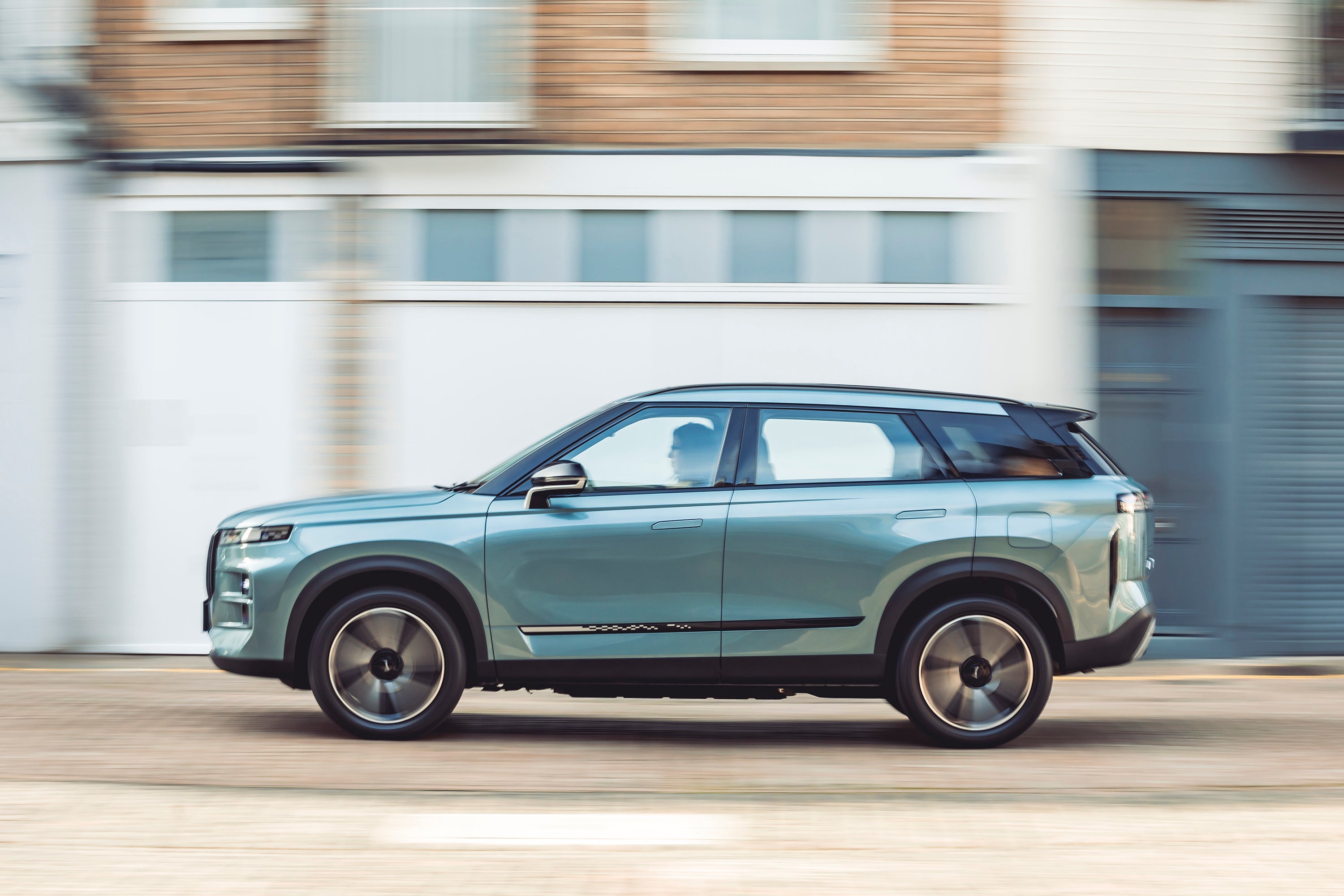Jaecoo 7 Review 2025: Price, specs & boot space
Written by Ivan Aistrop
Quick overview
Pros
- Small price and huge equipment
- Great quality, spacious and practical
- Brilliant warranty
Cons
- Pure-petrol cars have poorly resolved power delivery
- ADAS systems could be more polished
- Firm ride and so-so handling
Is the Jaecoo 7 a good car?
"The Jaecoo 7 enters the UK’s ultra-competitive midsize SUV market, hoping to stand out with its smart-yet-rugged style, its aggressive pricing, and its heaving equipment list. But will that be enough to guarantee success? Find out in out Jaecoo 7 review."
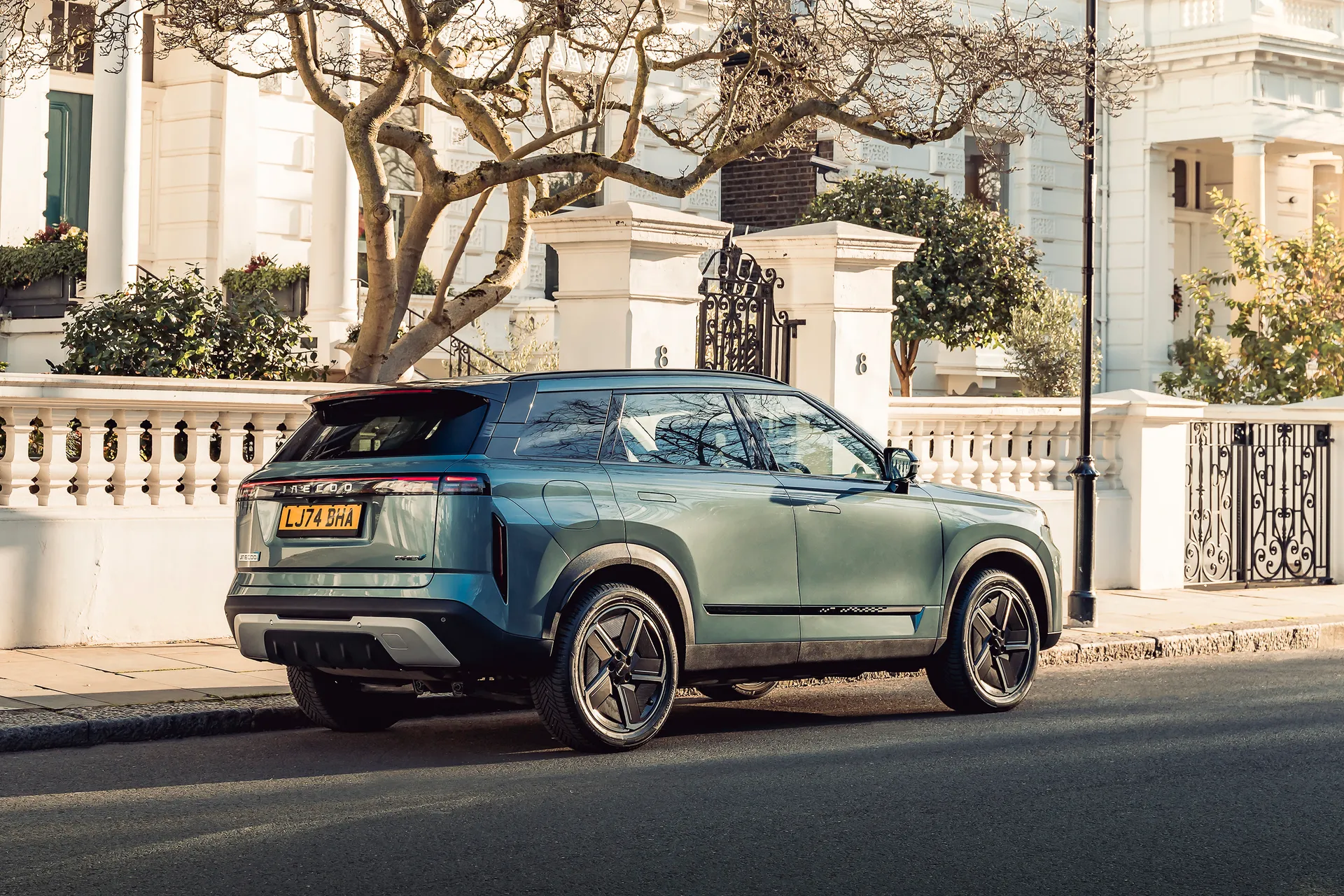
But before we get into the 7 itself, we should probably get a handle on the Jaecoo brand, because it’s more than likely a new name for you. This is a new Chinese brand that’s currently being launched across Europe, alongside a sister brand called Omoda. Both are owned and operated by a company called Chery, which in its homeland, is kind of a big deal. It’s China’s number one exporter of new passenger cars, and in 2023 alone, it sold 1.8 million cars in over 100 countries, under a variety of different brands. Now, Chery feels the time is right to take on the various European markets, and Jaecoo and Omoda are the brands with which they’ll do it.
The cars are built in China, but the company also has an R&D facility in Germany that fettles them to better suit European tastes. As we’ll find out later on in this review, this could be key to the Jaecoo 7’s success.
You might be thinking that the Jaecoo name is a little curious, and that’s because its origins are, too. The ‘Jae’ bit comes from the word ‘Jaeger’, which is the German word for ‘hunter’, while the ‘coo’ bit is the English word ‘cool’ with the end lopped off. Make of that what you will.
In terms of what the brand stands for, it sees itself as a rugged off-roading brand, but with a premium edge. Think what many folk see Land Rover or Range Rover as, and you won’t be too far wide of the mark.
The Jaecoo 7 itself is a mid-size SUV that’s about the same size as a Hyundai Tucson, a very popular family car. And sure enough, the 7 is roomy enough and practical enough to ably serve a similar purpose. It’s also super-impressive in terms of build quality, with plush materials and lots of tech, and it’s also stuffed with luxury kit. All that, and prices look very tempting, too.
As we’ll discover later in this review, there are a few fundamental dynamic shortcomings that need to be ironed out before the car can reach its full potential, but we’re sure that this can be done in relatively short order with over–the-air software updates. And we’ll let you know as soon as it has.
Is the Jaecoo 7 right for you?
If you want a midsize family SUV that’s roomy, practical, stylish, plushly finished, and absolutely stuffed with standard luxury and safety equipment, all for an eye-rubbingly low price that undercuts mainstream opposition, then yes, it most certainly is. However, it’s also certainly not the last word in dynamic excellence, with the pure-petrol versions having some fundamental flaws in how they deliver their power, so if that’s what you’re after, you’d probably best look elsewhere. That said, we’re hopeful that these flaws can be fixed, in the fullness of time, with over-the-air software updates.
What's the best Jaecoo 7 model/engine to choose?
Easy one, this. The plug-in hybrid. And not just because of its superior (on paper) fuel economy. As you’ll discover as this Jaecoo 7 review unfolds, the pure-petrol versions have some fundamental powertrain shortcomings that mean we’d recommend you steer clear of them for now. Hopefully, our hunch is right, and these shortcomings can be fixed with software updates in the future.
What other cars are similar to the Jaecoo 7?
The Jaecoo 7 is a fairly unconventional offering in the UK car market, but it’s not entirely without comparison. In terms of its design features and its rugged-yet-prestige pretensions, you immediately get a Range Rover Evoque/Velar vibe from it, albeit at a much lower price point. In that regard, it’s a more comparable competitor for stylish midsize family SUVs such as the Hyundai Tucson (which it’s also much more similar in size) although it holds a price advantage here, too. It shares a platform with the Omoda 5, which is another SUV recently launched by Jaecoo’s parent company, the Chinese manufacturing giant, Chery.
Comfort and design: Jaecoo 7 interior
"Slide into the driver’s seat, and you’ll find it to be very supportive, with lots of powered seat adjustment, and sufficient manual steering wheel adjustment, so most drivers will be able to find a comfortable driving position to suit them."

Your forward visibility is also pretty good, although a small rear window means that your rearward view isn’t quite so clear. However, that’s no surprise what with the sloping design of the roof at the rear end of the car.
One of the rather unconventional things about the Jaecoo 7 is that you get a fundamentally different interior design depending on which powertrain you go for. In the purely petrol-powered cars, the centre console houses a bulbous aircraft-style gear selector and a rotary drive mode switch, while door cards have robust grab handles and a collection of conventional switches and buttons for opening and closing your electric windows and adjusting your electric mirrors.
The plug-in hybrid, meanwhile, has a more minimalist vibe in order to make it feel more like an EV. The drive selector is moved up to the steering column, which results in a cleaner-looking centre console, while the switches on the doors are swapped with more futuristic-looking toggle-type ones.
Either way, though, the cabin is designed to be as minimalist as possible, meaning that there’s very little in the way of switches and buttons on the dashboard. This means that the vast majority of functions have to be operated through the touchscreen, which is more distracting. It’s certainly true that Jaecoo is far from alone in this over-reliance on touchscreen technology, but even so, we’d prefer it if at least the ventilation system could be operated with its own set of physical controls.
Quality and finish
This might be an area in which you’re expecting an affordable Chinese model like the Jaecoo 7 to be rather sub-par, but in actual fact, this is one of the areas in which the car impresses most.
Pretty much everywhere your eyes and fingertips fall, they’re met with materials that feel glossy, substantial and tactile, which instantly gives that cabin an impressively high-grade and plush feel, while the thoughtful selection of textures and finishes used makes things appear interesting as well as attractive.
The plush feel is also helped by the standard-fit strips of ambient lighting, the colour of which can be customised almost infinitely through the touchscreen.
Infotainment: Touchscreen, USB, nav and stereo in the Jaecoo 7
There are slight differences in infotainment spec depending on which trim level of the car you buy. All versions have a large portrait-orientated touchscreen in the middle of the dashboard, but this measures 13.2 inches screen in Deluxe trim and 14.8 inches in Luxury trim. Luxury trim also gets an additional pair of stereo speakers, with a total of eight compared to the Deluxe’s six.
Despite the differences, both setups use essentially the same touchscreen user interface, and both provide pretty much the same level of functionality. DAB, Bluetooth, native sat-nav, wireless phone charging are supported, and so are wireless Android Auto and Apple CarPlay. You also get four USB ports, two in the front and two in the rear seats. All versions also have a 10.25-inch digital driver display behind the steering wheel, which can be configured in a choice of layouts.
Compared to some of the user interfaces we’ve encountered lately, the Jaecoo’s actually isn’t half bad, with an intuitive and easy-to-follow list of menu shortcuts running down the left-hand side of the screen.
Granted, a couple of the submenus that they lead to are very long and convoluted, and because those submenus are essentially made up of a long list of on-or-off checkboxes, there’s very little visual differentiation between the various functions. On the positive side, though, most of the menus are short enough and logically arranged enough that they’re not too confusing, so once you’ve got used to the system, you can find your way around pretty easily.
Space and practicality: Jaecoo 7 boot space
You’d expect the front seats in any car to have ample space, and sure enough, that’s the case in the Jaecoo 7. That’s not necessarily a given in the rear seats, especially given the car’s sloping roofline and standard panoramic sunroof, but you might be pleasantly surprised on that score. There’s enough rear headroom for even tall passengers to get comfy, and rear legroom is also impressively generous.
Two passengers will be as happy as clams, and if needed, a third passenger can squeeze in with a reasonable level of comfort for short journeys, thanks to a relatively wide middle seat with an almost-flat floor in front of it. However, there’s not quite enough shoulder room for three people to sit comfortably across the rear bench for long periods, although in fairness, that’s the norm in this class of car.
The boot space you get in your Jaecoo 7 depends on which of the various powertrain options you go for. The front-wheel-drive car has a very competitive 500-litre boot capacity, but the low-slung load floor means that there’s a lip of a couple of inches tall at the entrance of the boot. When you drop the 60/40 split-folding rear seats, there’s also a small step up to the folded backrests: they also lie at a slight angle, leaving a slight slope in your extended load area.
Choose the 4WD or the PHEV versions, meanwhile, and the extra mechanical gubbins that they need to carry means that the boot floor has to be positioned a couple of inches higher up. That means it sits flush and level with both the boot lip and the folded rear seats, making the space more user-friendly, even if you ultimately get a little bit less of it at 412 litres.
Handling and ride quality: What is the Jaecoo 7 like to drive?
"The Jaecoo 7’s driving experience is dominated by its power delivery, and not in a good way according to what we experienced on our test drive. The rest of the driving experience, meanwhile, is a bit more convincing, but not utterly so."
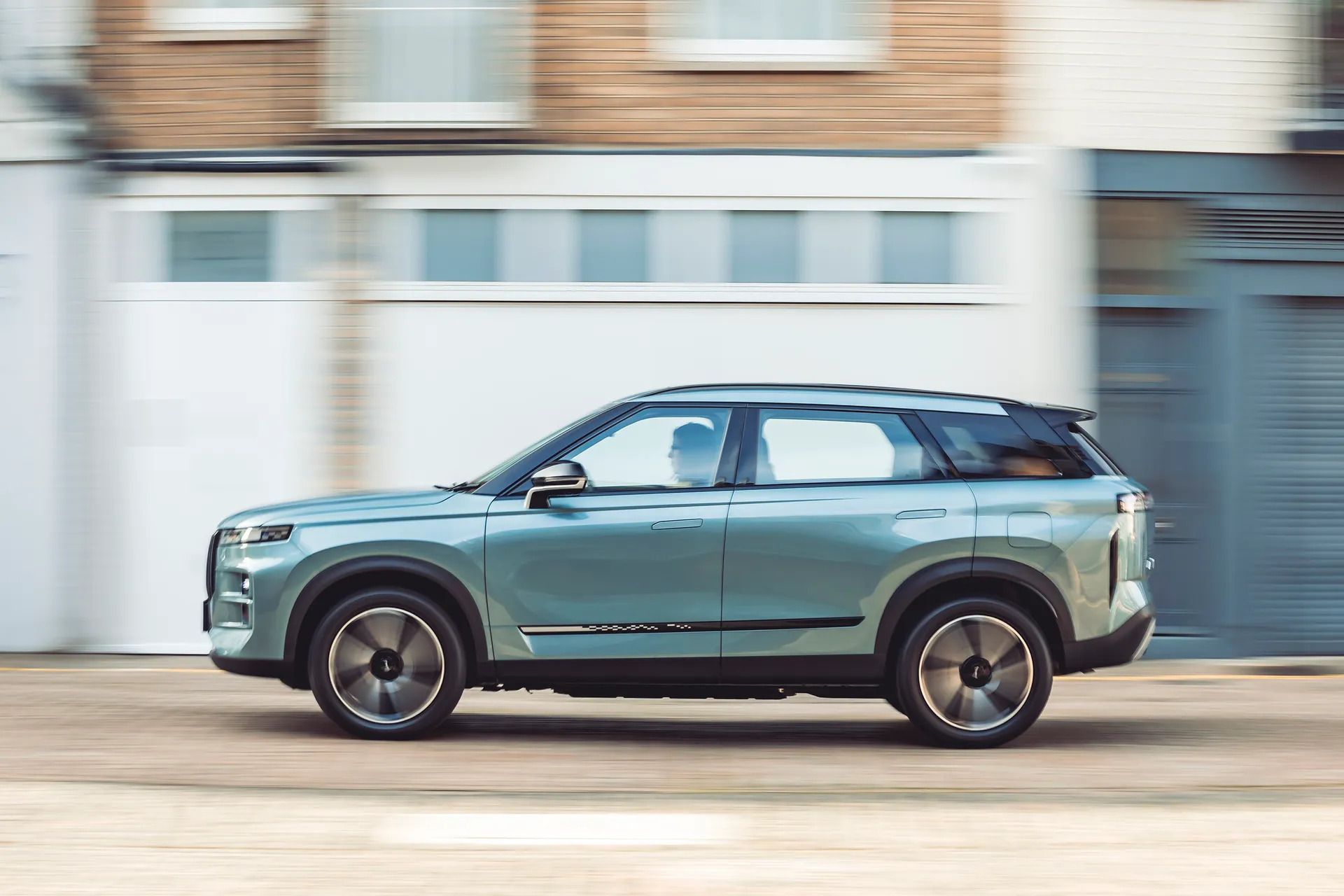
The first thing you’ll notice as you potter along is that the ride is definitely on the firm side, so while it’s okay on smooth Tarmac, things quickly get jittery and unsettled when the quality of the road surface beneath you deteriorates. And this applies at all speeds, from low to high.
The firmness in the suspension does mean that body movements are quite well tied down, so things don’t feel too floaty over crests and dips, and there’s not too much body lean as you turn corners, provided you do so at a reasonable speed. Not that you’re ever encouraged to do anything else, mind, because the steering has slow initial responses, and is rather short on feel.
What engines and gearboxes are available in the Jaecoo 7?
You have three choices of powertrain in the Jaecoo 7, with the first two possessing the same 147PS turbocharged 1.6-litre petrol engine, paired with a seven-speed dual-clutch automatic gearbox. The difference between them is that one comes with front-wheel drive and the other has four-wheel drive.
The front driver does the benchmark 0-62mph sprint in 10.3 seconds, while the all-wheel-drive car does it 11.8 seconds, the extra time probably being accounted for by the fact that it’s slightly heavier. In both of these versions, the pace on offer could be described as adequate but modest, but it’s the way the power is delivered that most captures the attention. And in the cars we experienced, not in a good way, unfortunately.
We think this is down to a variety of contributing factors. Firstly, you have a fly-by-wire throttle that’s very slow to respond, and that’s also very difficult to modulate accurately. At the same time, you also have an automatic gearbox that’s slow to engage at a standstill and slow to react on the move, and that’s also very keen to kick down without too much provocation.
The overall effect of all these various factors is that when you apply a normal amount of pressure to the throttle pedal, very little happens initially. So, you then push the pedal a couple of millimetres further, hoping to get the gentle acceleration you thought you’d asked for the first time, and then all of a sudden, the gearbox kicks down, the engine revs fly upwards toward the redline, and you surge forwards considerably faster than you intended. What’s more, you get this all-or-nothing power delivery regardless of whether you’re pulling away from the mark or building speed on the move.
In the four-wheel-drive car, this generally feels jerky, clumsy and untidy, and certainly not befitting of a car that is otherwise quite premium. However, things are exacerbated further in the front-wheel-drive car by the fact that, when that sudden surge of power finally does arrive, it usually spins up the front wheels, especially if the road is soggy, limiting both your traction and your control over the car. And, if this happens mid-corner, things can feel quite unnerving.
To us, these issues feel like they’re caused by slightly undercooked software for the gearbox and fly-by-wire throttle, rather than any fundamental shortcomings with the mechanical components and systems used. And in fairness, such teething troubles are not entirely surprising in a brand-spanking new model from a company that’s brand-spanking new to the UK.
The better news is that the car supports over-the-air updates for such things. So, if Jaecoo’s boffins can spend some time smashing out a few lines of code that get things working more smoothly - and we’ve politely suggested to them that they do - then these updates can be rolled out automatically without owners having to visit a dealer.
The other powertrain on offer is a plug-in hybrid that Jaecoo calls SHS, or Special Hybrid System. This combines a 1.5-litre turbocharged petrol engine with a couple of electric motors, delivering a total of 201bhp to the front wheels. This version will do the 0-62mph dash in 8.5 seconds, and with a full charge of the 18.3kWh battery, it can achieve an electric-only range of up to 56 miles, according to official WLTP figures.
The more interesting thing about the SHS, though, is what happens when your plug-in power is used up. You see, with most plug-in hybrids, things work at their optimum when your battery has plenty of juice in it. However, as soon as that juice runs out, the petrol engine gets pretty much no help from the electric motors, and what’s more, the powertrain also has to haul around the extra weight of the batteries and motors, often making the car thirstier than if it weren’t a hybrid at all.
Jaecoo claims that things are a bit different with the SHS, primarily because the battery is never allowed to fully deplete while there’s petrol in the tank, with the engine working alongside the regenerative braking system to top up the power levels as you go. This means that once your plug-in power is gone, there’s still enough energy in the battery for the car to effectively operate like a self-charging hybrid. That means the motors are always on hand to help out with the propulsion effort, making things more efficient.
Despite its advantage against the stopwatch, the PHEV doesn’t ultimately feel much quicker than the other versions. However, the PHEV powertrain is still the most pleasant one that the 7 has to offer because the power delivery is smoother, more consistent and more predictable than the all-or-nothing experience you get in the petrol-only versions.
Refinement and noise levels
We haven’t been awfully complimentary about the pure-petrol powertrains in the Jaecoo 7 so far, and unfortunately, their shortcomings also have an effect in this area. When the engine revs are suddenly sent sky-high, it results in a loud and irritating drone from the engine. In fact, the 1.6-litre petrol engine doesn’t have to be working all that hard to be making a racket, so engine noise is quite intrusive for quite a lot of the time. This is a shame because wind noise and road noise are actually quite well suppressed.
The hybrid is much better in this area. Because the electric motors are on hand to take some of the burden off the petrol engine when delivering the required amount of propulsion, the engine doesn’t have to work as hard as often, and so the revs aren’t sent skyward on a regular basis.
Safety equipment: How safe is the Jaecoo 7?
The Jaecoo 7 hasn’t yet been crash-tested by Euro NCAP. The Omoda 5 SUV, with which the car shares a platform, has, however, and it achieved the full five-star rating, which should hopefully bode well for its Jaecoo cousin.
Considering the vast amount of equipment on board the Jaecoo 7, it’ll be of very little surprise that the car also comes with an impressive variety of driver assistance systems as standard. We could list them all out, but for most people, it’ll just be a collection of meaningless words. Just rest assured that all the bases you could reasonably expect are covered (these include the important ones such as automatic emergency braking and adaptive cruise control), along with quite a few more.
In order to comply with legislation, these systems are always enabled automatically when the car is switched on. If you find such systems annoying, though - and many people do - it’s a very quick and simple process to disable them. You simply swipe downwards on the central touchscreen, and this brings up a collection of on-screen tiles that allow you to pick which functions to turn off. This is good because it means that you’re not hunting through submenu after submenu, distracting you further, and it’s the work of a moment to protect yourself from being bonged at every time you accidentally creep 1mph over the speed limit or get too close to a white line.
Unfortunately, bonging isn’t the total extent of the annoyances caused by the Jaecoo’s ADAS systems. Among them are a variety of lane regulation systems, including lane departure prevention and emergency lane-keeping assist. And, if the car thinks you’re wandering around too much, these apply steering effort to the wheel automatically to steer you back into your lane.
Now, this would all be fine, were it not for the fact that the system isn’t great at keeping the car in the centre of the lane. And, when you try to correct the car’s line yourself, the steering effort being applied by the car means that applying your own steering effort takes much more strength than it usually does. It feels a bit like being in a wrestling match with your own car, just to keep going in a straight line.
Yes, you can disable these systems in the manner we described earlier, but they’re automatically reinstated if you hit the button on the steering wheel (intentionally or accidentally, the latter of which is easy to do) that activates the adaptive cruise control.
Now, one of Jaecoo’s executives has assured us that the Chinese-built Jaecoo 7’s ADAS systems have already been polished up and improved with software updates applied by Jaecoo’s R&D centre in Germany. We think a little more work is needed on that front, but the good thing is that these software upgrades can be applied to cars via over-the-air updates.
MPG and fuel costs: What does a Jaecoo 7 cost to run?
"Quite predictably, the plug-in hybrid version of the Jaecoo 7 is the most parsimonious version on paper. Official WLTP figures put its fuel economy at 403mpg."
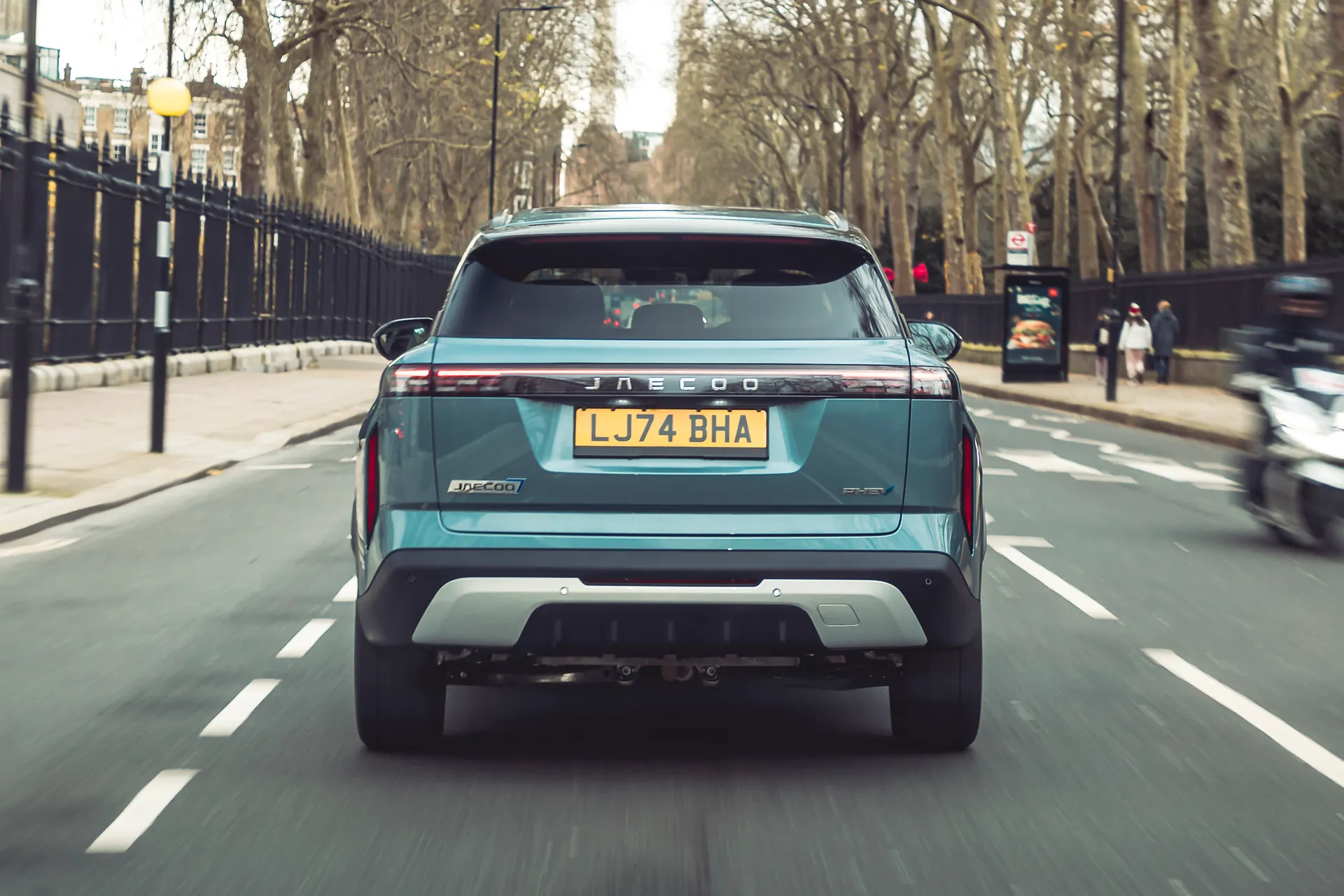
It pays to be wary of these figures where plug-in hybrids are concerned, though, because the official laboratory tests are unrealistically flattering to cars with this technology. As a result, don’t bank on getting near this figure in the real world.
That said, the 7’s electric-only range of 56 miles is towards the better end of the scale among plug-in hybrids, and the fact that it operates like a self-charging hybrid once your plug-in power runs down should mean that your overall fuel returns are improved compared with many PHEVs. For the best returns, keep your 18.3 kWh battery topped up with electricity and do mainly short journeys that you can complete without waking the petrol engine from its slumber.
AC charging takes place at a maximum rate of just 3.3 kW, and at that speed, a full charge of your PHEV takes around six and a half hours. DC happens at a maximum of 40kW, which can deliver a 30% to 80% top-up in 40 minutes.
So the petrols aren’t as good as the PHEV on fuel economy, then, but how are they compared to other petrol-powered SUVs? Well, they’re still a fraction thirsty. Official WLTP figures stand at 37.7 mpg for the front-wheel-drive car, and 35.3 mpg for the four-wheel-drive version. Meanwhile, the equivalent version of the Hyundai Tucson will get you upwards of 40mpg, according to the official figures.
Jaecoo 7 reliability and warranty
It’s always difficult to predict the long-term reliability of any brand-new model due to an absence of data on that model, and we often resort to looking at the historical performance of the car’s manufacturer in order to gain clues. However, because Jaecoo is a completely new brand to the UK, we can’t even do that. We’ll just have to wait until the car/brand has been around long enough to feature in the various reliability and customer satisfaction surveys doing the rounds.
Something that’ll give you cause for optimism, though, is Jaecoo’s standard warranty package, which is generous enough to bother some of the very best in the business. It comes with a seven-year, 100,000-mile warranty provided as standard, which matches the arrangement that Kia has long been lauded for, and Jaecoo’s offering is actually a little more generous still because the first three years have no mileage limit.
Jaecoo 7 insurance groups and costs
Insurance groups run from 1 to 50, and the lower the number of your car’s classification, the less you’re likely to pay for cover. The front-wheel drive version of the Jaecoo 7 sits in group 22, while oddly, the more expensive four-wheel drive version sits a group lower in group 21. That’s probably because the extra traction from its four-wheel driven powertrain is deemed to make it slightly safer. The PHEV version will be the priciest to insure, and by quite some distance, sitting in group 31.
VED car tax: What is the annual road tax on a Jaecoo 7?
All brand-new petrol and diesel cars registered since April 2017 have faced the same flat rate of annual VED road tax, and that rate is currently charged at £190 per year. You do currently get a discount if you go for the plug-in hybrid, but that amounts to only a tenner so that probably won’t be your reason for choosing it. Customers who buy cars that cost more than £40,000 when brand new are also slapped with an additional surcharge that adds another £410 to their annual VED bill for a period of five years, but thankfully, that doesn’t afflict any version of the Jaecoo 7 because it’s not possible to spend that much on one.
Jaecoo 7 price
"Even despite its dynamic shortcomings, there’ll be little argument that the Jaecoo 7 represents a vast amount of car for a very tempting amount of cash."
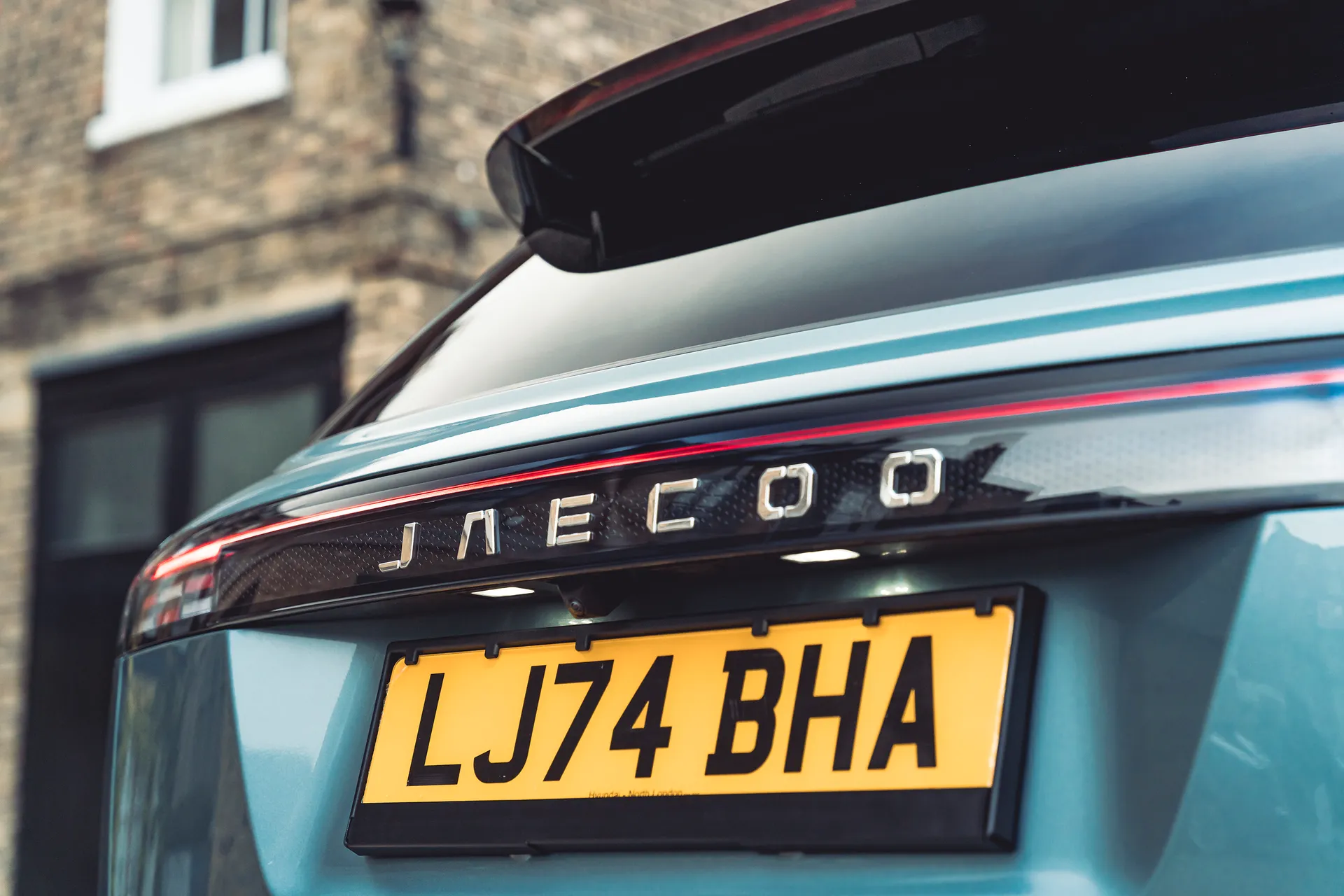
Prices for brand new examples start at approximately £30,000 for the entry-level front-wheel-drive petrol version, rising to around £33,000 for the higher spec four-wheel drive petrol. The range tops out with the SHS plug-in hybrid, costing around £35,000. Version-for-version, that undercuts the equivalent Hyundai Tucson by a very useful slice.
Usually, cars this new take quite a while to filter down onto the used car market, so finding a discounted pre-owned example can be quite difficult. That’s indeed the case with the Jaecoo 7 for now, but we expect that to change fairly quickly because quite a few examples have already been sold, we suspect mostly to dealers who have been registering them in order to help get the brand off the ground and get the product out there. So hopefully, it won’t be long before the heycar classifieds contain a good number of used examples at an even more attractive price.
Trim levels and standard equipment
There are two trim levels offered on the Jaecoo 7, the availability of which depends on what powertrain you choose. Go for the front-wheel-drive car, and it’ll come in Deluxe trim, while if you go for either the all-wheel drive version or the plug-in hybrid, your car will come exclusively in Luxury trim.
The good news is that both are incredibly well equipped as standard, especially considering the amount you pay for them. For a kick-off, Deluxe cars come with 19-inch alloy wheels, LED headlights with automatic full-beam function, rain-sensing wipers, front and rear parking sensors, a powered tailgate, a panoramic sunroof, heated and powered front seats, synthetic leather upholstery, and dual-zone air-conditioning. That’s on top of all the safety and infotainment gear we talked about earlier, which is also very generous.
On top of that little lot, Luxury trim adds a heated steering wheel, heated outer rear seats, and ventilated front seats, and a head-up display.
One interesting piece of kit that comes as standard on all 7s is the clever 540-degree parking camera system with a ‘Transparent Chassis’ function. This basically takes feeds from a number of different cameras dotted around the car, as well as underneath it, and pieces them all together to form one single moving image showing you a detailed view all around, and also what’s beneath you. It’s mainly designed for off-roading, allowing you to see and avoid potentially sump-smashing rocks, but it’s also useful in a variety of other road-based circumstances as well.
It can also get slightly annoying, though, because this view is applied to the central screen far too often. For example, you’ll be rolling along, following your sat-nav instructions, but when you need to make a turn and flick a signal with your indicators, your entire central screen is immediately taken over by this view, so your sat-nav instructions disappear. If your view of those instructions before they disappeared isn’t lodged in your memory, you won’t know where you’re going, and if you have to make a couple of turns in quick succession, you’ll have even less of an idea of where to go.
Ask the heycar experts: common questions
What is a Jaecoo 7?
Where does the name ‘Jaecoo’ come from?
Is the Jaecoo 7 electric?
Get our latest advice, news and offers
Keep me updated by email with the latest advice, news and offers from heycar.
By submitting you agree to our privacy policy
